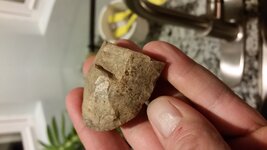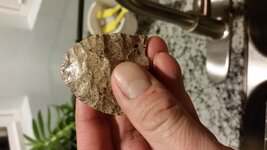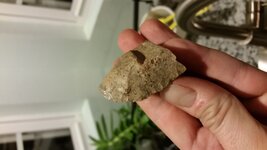Navigation
Install the app
How to install the app on iOS
Follow along with the video below to see how to install our site as a web app on your home screen.
Note: This feature may not be available in some browsers.
More options
You are using an out of date browser. It may not display this or other websites correctly.
You should upgrade or use an alternative browser.
You should upgrade or use an alternative browser.
Adze?
- Thread starter Bmillby
- Start date
kcm
Gold Member
Looks more like something used for shaping/smoothing the inside rounds of bowls.
quito
Silver Member
Looks like a broken uni-face knife from what I can see. Also looks like the flute could have been the result of the breaking of it.
sandchip
Silver Member
- Oct 29, 2010
- 4,351
- 6,873
- Detector(s) used
- Teknetics T2SE
- Primary Interest:
- All Treasure Hunting
Looks like a broken uni-face knife from what I can see. Also looks like the flute could have been the result of the breaking of it.
Just what I was thinking, judging by the way the flake scar rolls over the broken end. Still a nice piece and beautiful material.
- Jul 27, 2006
- 48,659
- 55,413
- Detector(s) used
- Minelab_Equinox_ 800 Minelab_CTX-3030 Minelab_Excal_1000 Minelab_Sovereign_GT Minelab_Safari Minelab_ETrac Whites_Beach_Hunter_ID Fisher_1235_X
- Primary Interest:
- All Treasure Hunting
Agree with Quito......Looks like a broken uni-face knife from what I can see. Also looks like the flute could have been the result of the breaking of it.
Charl
Silver Member
If there is flaking on both sides, and there appears to be, then I don't think it can be called unifacial. I think it's bifacial, whatever it is......
kcm
Gold Member
In any case, it IS interesting!! 

Sure looks like the bit end of a broken Adze to me. Appears to me to have the typical bevels and the classic use polish right where it always appears.
It's hard to capture the bit bevels in a picture. A head on picture and a side view might be helpful.
Nice find
It's hard to capture the bit bevels in a picture. A head on picture and a side view might be helpful.
Nice find
Bmillby
Tenderfoot
- Thread starter
- #9
It appears like my finger in the second picture is covering the fluted area, but it isn't, that is the other side. The part of the "flute" where it is broken is also a bit polished as if it was hafted there and also wore a once sharp corner. Plus, both sides show quite a polish on the bit end. Thanks all for the input.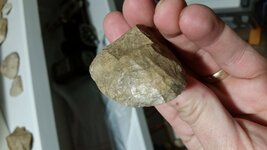
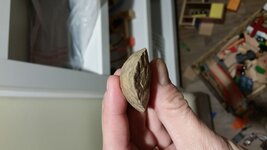
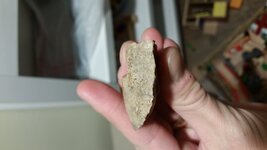
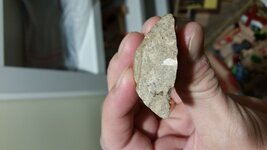




Last edited:
I could tell that the second picture was the under side. The head-on picture that you added of the blade/bit edge confirms that it's a broken Adze. That style is fairly common here in Illinois where I am at, the body shape can vary quite a bit as well as the size, only a couple that I've found show the heavy use polish. Here's a few pics. of some that I've found...It appears like my finger in the second picture is covering the fluted area, but it isn't, that is the other side. The part of the "flute" where it is broken is also a bit polished as if it was hafted there and also wore a once sharp corner. Plus, both sides show quite a polish on the bit end. Thanks all for the input.View attachment 1295378View attachment 1295379View attachment 1295380View attachment 1295381
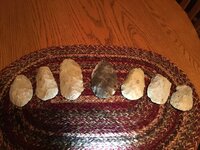
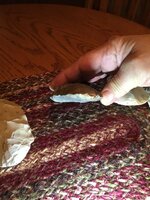
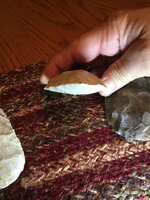
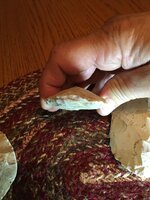
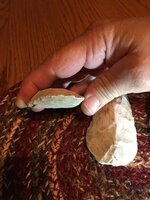
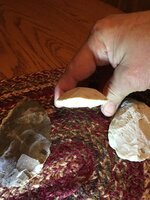
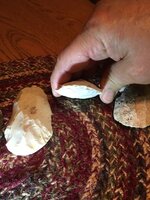
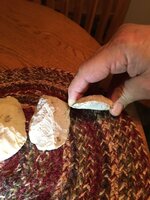
quito
Silver Member
If there is flaking on both sides, and there appears to be, then I don't think it can be called unifacial. I think it's bifacial, whatever it is......
I'm wondering how you saw the other side when it wasn't shown.
Good guess Charl. :-)
Charl
Silver Member
I'm wondering how you saw the other side when it wasn't shown.
Good guess Charl. :-)
But, as he noted, both sides were indeed shown in the first set of pics. It's actually very obvious that both sides are shown there. The flaking on the second photo is on a flat side, and not the convex side shown in the first photo. It was not a guess at all; my eyes told me both sides were being shown :-)
And the second set confirms adze, as Mark has noted. The head-on shot of the bit confirms adze, IMHO......
Last edited:
quito
Silver Member
ahh, I see that now. That's what I get for scanning things over to quickly sometimes.
Top Member Reactions
-
 1962
1962 -
 1103
1103 -
 1070
1070 -
 997
997 -
 880
880 -
 867
867 -
 839
839 -
 792
792 -
 739
739 -
 600
600 -
 447
447 -
 374
374 -
 356
356 -
 344
344 -
 344
344 -
E
341
-
 340
340 -
 317
317 -
 294
294 -
 289
289
Users who are viewing this thread
Total: 2 (members: 0, guests: 2)


